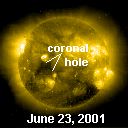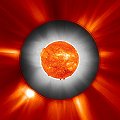|   SPACE WEATHER SPACE WEATHER
Current
Conditions
Solar Wind
velocity: 470.2 km/s
density:2.5 protons/cm3
explanation | more data
Updated: Today at 2245 UT
X-ray Solar Flares
6-hr max: C3 1730 UT Jun23
24-hr: M6 0405 UT Jun23
explanation | more data
Updated: Today at 2245 UT
Daily Sun: 22 Jun '01 
Active regions 9503 and 9511 each have twisted beta-gamma magnetic fields that could harbor energy for strong M-class solar flares. Image credit: SOHO/MDI
The Far Side of the Sun
This holographic image reveals a substantial sunspot group on the far side of the Sun. Image credit: SOHO/MDI
Sunspot Number: 203
More about sunspots
Updated: 22 Jun 2001
Radio Meteor Rate
24 hr max: 31 per hr
Listen to the Meteor Radar!
Updated: 21 Jun 2001 Interplanetary Mag. Field
Btotal: 7.4 nT
Bz: 3.6 nT south
explanation | more data
Updated: Today at 2247 UT Coronal Holes:

A small coronal hole is forming near the fast-growing sunspot 9511. The hole could send solar wind gusts toward Earth when it crosses the middle of the Sun a few days hence. Image credit: SOHO Extreme UV Telescope.
More about coronal holes
 SPACE WEATHER SPACE WEATHER
NOAA
Forecasts
Solar Flares: Probabilities for a medium-sized (M-class) or a major (X-class) solar flare during the next 24/48 hours are tabulated below.
Updated at 2001 Jun 23 2200 UT
| FLARE | 24 hr | 48 hr | | CLASS M | 50 % | 50 % | | CLASS X | 10 % | 10 % |
Geomagnetic Storms: Probabilities for significant disturbances in Earth's magnetic field are given for three activity levels: active, minor storm, severe storm
Updated at 2001 Jun 23 2200 UT Mid-latitudes | 24 hr | 48 hr | | ACTIVE | 20 % | 20 % | | MINOR | 10 % | 10 % | | SEVERE | 01 % | 01 % |
High latitudes | 24 hr | 48 hr | | ACTIVE | 25 % | 25 % | | MINOR | 15 % | 15 % | | SEVERE | 01 % | 01 % |

Web server provided by
VPS Hosting
| What's Up in Space -- 23 Jun 2001
Subscribe to Space Weather News! SOLAR FLARES: Sunspots 9503 and 9511 have each unleashed strong M-class solar flares during the past 24 hours. The active regions exhibit twisted beta-gamma magnetic fields that probably harbor energy for more such explosions. Eruptions from 9511, which will cross the Sun's central meridian in the days ahead, would likely be Earth-directed. 
Above: This movie shows recent activity in active regions 9511 (left) and 9503 (right) as seen through SOHO's extreme ultraviolet telescope.  AMAZING! Onlookers cried out in delight in Lusaka, Zambia, Thursday when the Moon covered the Sun and revealed the dazzling corona. NASA astronomer Mitzi Adams, with students and scientists from Williams College, was on the scene narrating events via streaming web audio. Click for replays of the event, including sights, sounds, and temperature readings from the path of totality. Above: This combination of space- and ground-based images reveals the dynamic Sun during yesterday's eclipse. [more] AMAZING! Onlookers cried out in delight in Lusaka, Zambia, Thursday when the Moon covered the Sun and revealed the dazzling corona. NASA astronomer Mitzi Adams, with students and scientists from Williams College, was on the scene narrating events via streaming web audio. Click for replays of the event, including sights, sounds, and temperature readings from the path of totality. Above: This combination of space- and ground-based images reveals the dynamic Sun during yesterday's eclipse. [more]
Visit the SpaceWeather.com Eclipse Gallery  AURORAS: A dense interplanetary shock wave struck Earth's magnetosphere on June 18th and lit up the midnight skies above North America with shimmering auroras. The disturbance began its journey toward Earth last Friday when a coronal mass ejection (CME) billowed away from the Sun. Although that CME was not Earth-directed, the expanding cloud generated a "bow shock" as it plowed through the gaseous interplanetary medium, and that bow shock struck our planet's magnetic field. AURORAS: A dense interplanetary shock wave struck Earth's magnetosphere on June 18th and lit up the midnight skies above North America with shimmering auroras. The disturbance began its journey toward Earth last Friday when a coronal mass ejection (CME) billowed away from the Sun. Although that CME was not Earth-directed, the expanding cloud generated a "bow shock" as it plowed through the gaseous interplanetary medium, and that bow shock struck our planet's magnetic field.

Above: The Planetary K-index rose to storm levels on June 18th. THE BIGGEST EXPLOSIONS IN THE SOLAR SYSTEM: NASA's HESSI spacecraft aims to unravel an explosive mystery: the origin of solar flares. [full story] WEB LINKS: NOAA FORECAST | GLOSSARY | SPACE WEATHER TUTORIAL | LESSON PLANS | BECOME A SUBSCRIBER | 
Potentially Hazardous Asteroids (PHAs) are space rocks larger than approximately 100m that can come closer to Earth than 0.05 AU. None of the known PHAs are on a collision course with our planet, although astronomers are finding new ones all the time. [more]
On 23 Jun 2001 there were 312 known Potentially
Hazardous Asteroids May-June 2001 Earth-asteroid encounters | ASTEROID | DATE (UT) | MISS DISTANCE | | 2001 FE90 | 2001-May-06 23:37 | 49.7 LD | | 1999 KW4 | 2001-May-25 23:31 | 12.6 LD | | 2001 JV1 | 2001-Jun-06 07:53 | 18.0 LD | Note: LD is a "Lunar Distance." 1 LD = 384,401 km, the distance between Earth and the Moon. 1 LD also equals 0.00256 AU. 
- TOTAL LUNAR ECLIPSE: On Jan. 9, 2001, the full Moon glided through Earth's copper-colored shadow. [gallery]
- CHRISTMAS ECLIPSE: Sky watchers across North America enjoyed a partial solar eclipse on Christmas Day 2000 [gallery]
- LEONIDS 2000: Observers around the globe enjoyed three predicted episodes of shooting stars. [gallery]
 Feb. 21, 2001: Nature's Tiniest Space Junk -- Using an experimental radar at the Marshall Space Flight Center, scientists are monitoring tiny but hazardous meteoroids that swarm around our planet. Feb. 15, 2001: The Sun Does a Flip -- NASA scientists who monitor the Sun say our star's enormous magnetic field is reversing -- a sure sign that solar maximum is here. Jan. 25, 2001: Earth's Invisible Magnetic Tail -- NASA's IMAGE spacecraft, the first to enjoy a global view of the magnetosphere, spotted a curious plasma tail pointing from Earth toward the Sun. Jan. 4, 2001: Earth at Perihelion -- On January 4, 2001, our planet made its annual closest approach to the Sun. Dec. 29, 2000: Millennium Meteors -- North Americans will have a front-row seat for a brief but powerful meteor shower on January 3, 2001. Dec. 28, 2000: Galileo Looks for Auroras on Ganymede -- NASA's durable Galileo spacecraft flew above the solar system's largest moon this morning in search of extraterrestrial "Northern Lights" Dec. 22, 2000: Watching the Angry Sun -- Solar physicists are enjoying their best-ever look at a Solar Maximum thanks to NOAA and NASA satellites. MORE SPACE WEATHER HEADLINES |

